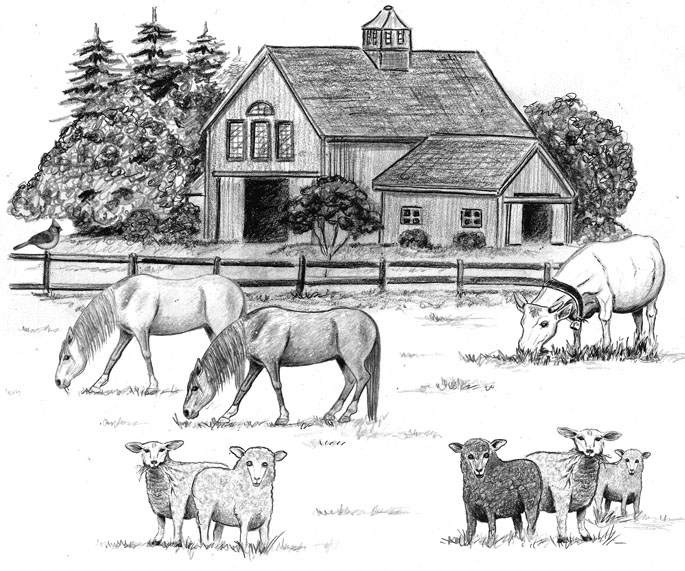
Drumlin Farm,
The Massachusetts Audubon Society owns and operates sixty wonderful wildlife sanctuaries throughout the state, and I’ve visited an awful lot of them. In the town of Lincoln, across the street from the Society’s headquarters, is their most popular sanctuary, Drumlin Farm. This refuge is noted for its educational programs, for being an actual working farm and for its well-stocked gift shop. I decided I needed to visit this property, especially the gift shop. (I like to check out the competition.)
Because of the dreaded city traffic, we drove up the night before and stayed at a Hampton Inn alongside the equally dreaded Rt. 128. A mere six miles from the Rt. 128 congestion, is picturesque Drumlin Farm. There is plenty of parking, including several places where electric vehicles can recharge (nice touch, Audubon). I plugged in my car and headed to the entrance. Unfortunately, the sanctuary doesn’t open until 9:00AM. What? To most birders, 9:00AM puts it in the “Why bother?” category. While we waited for 9:00, we chased after a large flock of bluebirds that were also waiting for the place to open.
Most Audubon sanctuaries consist of important habitat preservation and assorted hiking trails. This is not necessarily the case here. Drumlin Farm was donated to the Society in 1955 by Louise Ayer Hatheway, who requested that the property remain an active farm. They have honored her request. I assumed we were there to look for birds, but as soon as they let us in, my wife headed right for the pig barn. I could hear a lot of squealing from the barn and most of it was coming from my wife. (She likes pigs.) She also spent time talking to the chickens, petting the goats, mooing at cows and taking selfies with the sheep. By the end of the first hour, she smelled like a farmhand, but was having fun. My bird watching could wait.
Drumlin Farm also has an area known as Bird Hill, where live birds are kept. They had Barred Owls, Great Horned Owls, Red-shouldered Hawks, and even a fisher. Red foxes were sunning themselves in a nearby pen, which was adjacent to an enclosure containing a cotton-tailed rabbit. I felt bad for the rabbit. Imagine waking up each morning and seeing a pair of hungry foxes staring at you. Talk about not liking your neighbors. It should be pointed out that Drumlin Farm is not a zoo. They only house a handful of rehabbing animals that are non-releasable. The most common sources of their injuries are from cars, cell towers and for the younger ones, skateboarding.
Things got a little more birdie when we moved on to the agricultural area of the property. Some of the fields were still being worked, but others were attracting Savanna Sparrows, Chipping Sparrows, Carolina Wrens and a large flock of Cedar waxwings. On the way back to the car we watched an Eastern Phoebe catching fall insects and spent more time chasing the same flock of bluebirds. (I enjoy bluebirds much in the same way my wife likes pigs.)
Drumlin Farm isn’t the best spot for hardcore birders, but it’s a great place for parents with kids, or grandparents with kids or anyone who is stuck spending the day with someone else’s kids. This sanctuary is both beautiful and educational, and it has one of the best birding shops I’ve seen…but not “the best” (wink, wink). While admission is free for members, everyone else has to pay. It would be wise to become a member. Now that I’ve said the nice things, I’m about to throw some shade, as they say.
Every day I tell customers their bird feeders need to be regularly maintained. If they can’t properly maintain their feeders, then they shouldn’t feed birds. It’s that simple. The Massachusetts Audubon Society is, by far, one of the most important conservation organizations in the country, but…the bird feeders at Drumlin Farm are disgusting. At the entrance there is an area dedicated to bird feeding and all of their feeders were broken, chewed-up and dirty. Only one feeder contained birdseed, but the seed was old and moldy. Damaged and dirty feeders, and moldy seed are dangerous to birds. Shame on you, Mass Audubon. You know better and need to set a better example. There, I said it.
The nearby town of Concord is noted for its historical significance and for several natural areas, including Henry David Thoreau’s Walden Pond. We almost stopped at Walden Pond, but at the last minute I opted for Great Meadows National Wildlife Refuge (sorry, Henry). This area is undoubtedly less busy than Walden Pond and features several easy walking trails. One trail crosses over a dike, which separates two impoundments. The impoundments provide habitat for ducks, herons, rails, bitterns and Marsh Wrens. It was now midday and the birds were fairly quiet. The best bird we saw was a leopard frog hopping across the trail, which was fun to see since leopard frogs don’t breed on Cape Cod. We next came upon a nice birder lady who gave us an informative history of the refuge, including their effort to preserve the threatened Blanding’s Turtle. I had never heard of this species before, but I acted like I had. She suggested we return in the spring when the birding is a bit better and the refuge’s famous lotus flowers are in bloom. That’s all my wife needed to hear. She’s now working on a return trip in the spring to see the flowers. On that same trip, I plan to swing by Drumlin Farm to re-inspect their feeders. Your feeding area had better be improved this time, Drumlin. I’m watching you.